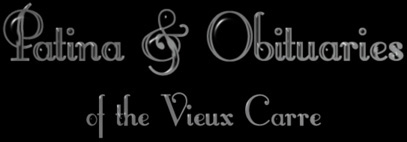
The Charm of Crumbling Bricks and Peeling Paint
Photos from New Orleans’ French Quarter capture history, mystique
By Pamela Dillon, Dayton Daily News
Feature Article for Dayton Daily News Arts section, November 14, 2004
The final resting place that
has captured his attention holds so much fascination and notoriety that
visitors aren’t allowed in after 3 p.m.
But that’s OK with fine
art photographer Robert Miller because the light wouldn’t be good after
dusk anyway.
Miller traveled to the French
Quarter of New Orleans to capture the history and character of tomb-sites
inside St. Louis Cemetery No.1,
as well as the elaborate
courtyard doors and windows of homes in the area.
“Patina & Obituaries
of the Vieux Carre” includes 26 images on display at the Carriage
Hill MetroPark Gallery.
“The whole French Quarter
has a certain look and feel to it, and everything is different.
Every door, every window,
every doorknob has its own character,” Miller said.
“They’re really proud of
that aged look and unique patina.”
Crumbling bricks, peeling
paint and rotting wood would send most people around here to Lowe’s for
new parts and materials.
But in the Vieux Carre,
it’s all part of the history and mystique.
Miller took mostly large
format images with a Shen Hao HZX-45A, a 4x5 Chinese camera encased in
wood with an accordion bellows.
He uses a slow, traditional
process to set up and capture the shot.
When he returns to the darkroom,
he spends an entire day developing two negatives at a time in a rare process
called unsharp masking.
He creates a positive image
of the original negative on another piece of film, then places both together
in an enlarger.
“You get a much sharper image
because the negatives don’t have to be enlarged that much.
You gain tonality and greater
shadow detail,” said Miller.
That sharpness comes through
in Maison du Lenny Kravitz, an image of the musician’s courtyard
door.
The distress patches from
the cracked, peeling paint are so numerous, the resulting dark and light
contrasts resemble an abstract painting.
“What you don’t see are
all the pale, pastel colors. When I was there, a local resident came
by and asked if I knew whose door I was photographing,” said Miller.
“He told me it belonged
to Lenny Kravitz and that he spent thousands of dollars to get his door
to look like that.”
Doors from other not-so-famous
people include Oak Design on Courtyard Door, a close-up of
an intricate metal oak branch design inside a small portal;
and White Porcelain
Doorknob, a stark contrast of white against the darkly painted
wooden door, that is again contrasted within a lighter concrete framework.
When he visited St. Louis Cemetery #1, he captured the disintegration of ancient tombs with their crumbling bricks, chipped marble ledges and leaning iron posts.
Simple Gifts is particularly poignant, with a small stuffed elephant toy and beads decorating the side ledge of a tomb that has rotted away in the corner.
Bird Bones
captures an untidy mess of small bones and feathers on the concrete beside
a grave.
The remainder of a predator’s
meal, a dark gift or perhaps voodoo,
it is a stark reminder of
the reality of death for all humans and animals.
“I love the way the texture
appears with everything falling apart.
Old things have a strength
and character that modern materials just don’t posses,” said Miller.
He started taking photographs
as a child, and when his parents bought him a 35mm camera after high school
graduation,
then learned by “making
every mistake in the book” until he developed his own style.
His photographs evoke strong
feelings and he is known for capturing Appalachian culture.
The Carriage Hill Gallery
opened last June, when Miller exhibited his Heartwood series
from Appalachia.
This exhibition runs through
December 31, 2004 and is open Monday through Friday from 10 a.m. to 5 p.m.,
and weekends 1 to 5 p.m.
“A woman came through today
to see the exhibition, and she was just thrilled,“ said Carriage Hill receptionist
Ann Sykora.
“She had visited New Orleans
and seen some of these places in person. She said the exhibition
stirred intense feelings and memories."
_
Contact DDN arts writer
Pamela Dillon at pdillon112ATaol.com (replace
“AT” with “@”)